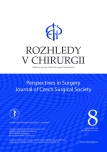Long-term patient follow-up after post-kidney transplant symptomatic lymphocele therapy
Authors:
J. Pacovsky 1,2; M. Matysková Kubišová 2,3; P. Navrátil 1,2; I. Novák 1,2; I. Guňka 2,4; M. Broďák 1
Authors‘ workplace:
Urologická klinika FN a LF UK Hradec Králové
1; Mezioborové transplantační centrum FN a LF UK Hradec Králové
2; Hemodialyzační středisko FN a LF UK Hradec Králové
3; Chirurgická klinika FN a LF UK Hradec Králové
4
Published in:
Rozhl. Chir., 2019, roč. 98, č. 8, s. 321-325.
Category:
Original articles
doi:
https://doi.org/10.33699/PIS.2019.98.8.321–325
Overview
Introduction: Symptomatic lymphocele could impair the function of a graft kidney. The aim of our research was to conduct a five-year follow-up after symptomatic lymphocele therapy.
Methods: Overall 50 patients undergoing the therapy of symptomatic lymphocele were enrolled in the study cohort. Demographic data, renal failure causes, indication of therapy and lymphocele management were retrospectively evaluated. Laboratory tests were done to evaluate serum creatinine, total plasma protein and albumin levels. Survival rates of the patients and of the grafts were analysed using Kaplan-Meier curves.
Results: The mean age of the 50 patients (44% females, 56% males) was 51.5±11.8 years, and the time between kidney transplantation and symptomatic lymphocele diagnosis was 12.8±21.5 months. Average lymphocele diameter was 71±35 mm. Causes of the native kidney failure were: glomerulonephritis (34%), tubulointerstitial nephritis (30%), polycystosis (24%), diabetic nephropathy (10%) and nephrosclerosis (2%). The therapy indications were: serum creatinine elevation (44%), graft hydronephrosis (38%), serum creatinine elevation associated with hydronephrosis (8%), infection associated with hydronephrosis (6%) and infection (4%). The lymphocele was managed by: open surgical intraperitoneal drainage (40%), percutaneous aspiration (26%), percutaneous long-term drainage (18%) and laparoscopic intraperitoneal drainage (16%). Mean serum creatinine levels at the time of the therapy and 60 months later were 231 µmol/L and 172 µmol/L, respectively; total plasma protein levels were 59 g/L and 69 g/L, respectively; albumin plasma levels were 36 g/L and 43 g/L, respectively. The five-year patient survival rate was 86% and the graft survival rate was 66%.
Conclusion: Adequate management of symptomatic lymphocele stabilizes the graft function. If the post-transplant lymphocele is indicated for therapy, the therapy should be applied as soon as possible to prevent fibrous changes in the surrounding tissues. No patient death or graft loss had any direct relationship with lymphocele management.
Keywords:
lymphocele – indication – long-term results
Sources
- Sim A, Ng LG, Cheng C. Occurrence of a lymphocele following renal transplantation. Singapore Med J. 2013;54:259−62.
- Minetti EE. Lymphocele after renal transplantation, a medical complication. J Nephrol. 2011;24:70−16. doi: 10.5301/jn.5000004.
- Pacovský J, Brod‘ák M, Navrátil P. Therapy of lymphocele following kidney transplantation. Rozhl Chir. 2008;87:59−60.
- Pacovský J, Hyšpler R, Navrátil P, et al. Úloha proteinů v patogenezi lymfokély po transplantaci ledviny. Urológia 2007;13:31−3.
- Neeff HP, Pisarski P, Tittelbach-Helmrich D, et al. One hundred consecutive kidney transplantations with simultaneous ipsilateral nephrectomy in patients with autosomal dominant polycystic kidney disease. Nephrol Dial Transplant. 2013;28:466−71. doi: 10.1093/ndt/gfs118.
- Mehrabi A, Golriz M, Maier J, et al. Long-term follow-up of kidney transplant recipients with polycystic kidney disease. Exp Clin Transplant. 2015;13:413−20.
- El Atat R, Derouiche A, Guellouz S, et al. Surgical complications in pediatric and adolescent renal transplantation. Saudi J Kidney Dis Transpl. 2010;21:251−7.
- Krajewski W, Piszczek R, Weyde W, et al. Lymphocele--urological complication after renal transplantation. Postepy Hig Med Dosw. 2013;23;326−30.
- Giuliani S, Gamba P, Kiblawi R, et al. Lymphocele after pediatric kidney transplantation: incidence and risk factors. Pediatr Transplant. 2014;18:720−5. doi: 10.1111/petr.12341.
- Shokeir AA, el-Diasty TA, Ghoneim MA. Percutaneous treatment of lymphocele in renal transplant recipients. J Endourol. 1993;7:481−5. doi:10.1089/end.1993.7.481
- Sawhney R, D‘Agostino HB, Zinck S, et al. Treatment of postoperative lymphoceles with percutaneous drainage and alcohol sclerotherapy. J Vasc Interv Radiol. 1996;7:241−5.
- Adani GL, Baccarani U, Bresadola V et al. Graft loss due to percutaneous sclerotherapy of a lymphocele using acetic acid after renal transplantation. Cardiovasc Intervent Radiol. 2005;28:836−8. doi:10.1007/s00270-005-0002-7.
- Lundin C, Bersztel A, Wahlberg J, et al. Low molecular weight heparin prophylaxis increases the incidence of lymphocele after kidney transplantation. Ups J Med Sci. 2002;107:9−15. doi:10.3109/2000-1967-137.
- Pacovsky J, Hyspler R, Husek P, et al. Colloid osmotic pressure participates on the post-transplant lymphocele pathogenesis. Transplant Proc. 2018;50:3422−5. doi: 10.1016/j.transproceed.2018.06.043.
Labels
Surgery Orthopaedics Trauma surgeryArticle was published in
Perspectives in Surgery

2019 Issue 8
- Metamizole vs. Tramadol in Postoperative Analgesia
- Metamizole at a Glance and in Practice – Effective Non-Opioid Analgesic for All Ages
- Obstacle Called Vasospasm: Which Solution Is Most Effective in Microsurgery and How to Pharmacologically Assist It?
Most read in this issue
- Injuries of the small and large intestine
- Psychological influences on wound healing
- Long-term patient follow-up after post-kidney transplant symptomatic lymphocele therapy
- Lymphomas and acute abdomen – a set of case reports
